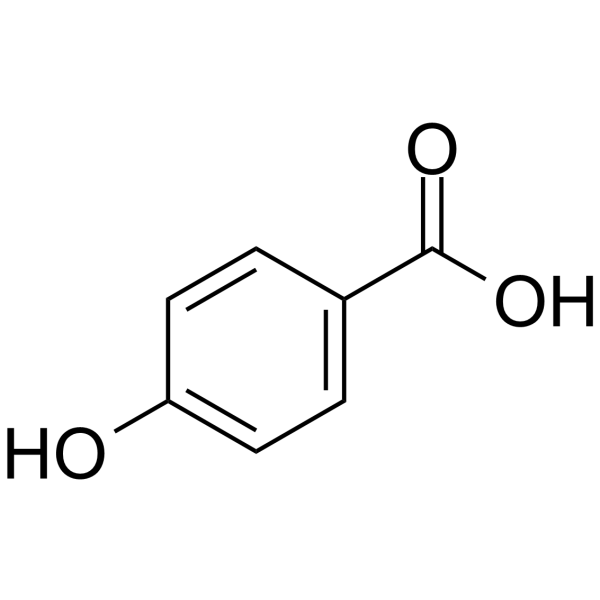天然产物 天然产物苯丙素类 Phenylpropanoids
4-Hydroxybenzoic acid 纯度: ≥98.0%
4-Hydroxybenzoic acid 是苯甲酸的酚衍生物,可以抑制绝大多数的革兰氏阳性菌和部分革兰氏阴性菌,其 IC50 值为160 μg/mL。

4-Hydroxybenzoic acid Chemical Structure
CAS No. : 99-96-7
| 规格 | 价格 | 是否有货 | 数量 |
|---|---|---|---|
| Free Sample (0.1-0.5 mg) | Apply now | ||
| 10 mM * 1 mL in DMSO | ¥500 | In-stock | |
| 500 mg | ¥400 | In-stock | |
| 1 g | ¥500 | In-stock | |
| 5 g | 询价 | ||
| 10 g | 询价 |
* Please select Quantity before adding items.
4-Hydroxybenzoic acid 相关产品
•相关化合物库:
- Natural Product Library Plus
- Bioactive Compound Library Plus
- Anti-Infection Compound Library
- Metabolism/Protease Compound Library
- Natural Product Library
- Human Endogenous Metabolite Compound Library
- Fragment Library
- Antibacterial Compound Library
- Phenols Library
- Traditional Chinese Medicine Monomer Library
- FDA Approved & Pharmacopeial Drug Library
- Gut Microbial Metabolite Library
- Microbial Metabolite Library
- Food Additive Library
- Food-Sourced Compound Library
| 生物活性 |
4-Hydroxybenzoic acid, a phenolic derivative of benzoic acid, could inhibit most gram-positive and some gram-negative bacteria, with an IC50 of 160 μg/mL. |
||||||||||||||||
|---|---|---|---|---|---|---|---|---|---|---|---|---|---|---|---|---|---|
| IC50 & Target[1] |
|
||||||||||||||||
| 体外研究 (In Vitro) |
Most of the gram-positive and some gram-negative bacteria are sensitive to trans 4-Hydroxycinnamic acid (4-HBA) and 4-Hydroxybenzoic acid at IC50 concentrations of 100-170 and 160 μg/mL, respectively. The antimicrobial activities of 4-Hydroxycinnamic acid and t4-HCA against 11 food pathogenic bacteria, 6 plant pathogenic bacteria, 2 yeasts and 15 plant pathogenic fungi are tested by the paper disc method. These compounds inhibit the growth of most of the bacteria and yeasts at concentrations of 200-400 μg. However, the inhibition is more effective against most of the gram-positive bacteria. When tested by the paper disc method, 4-Hydroxycinnamic acid has stronger antimicrobial activity than t4-HCA against S. aureus, L. mesenteroides, S. cerevisiae and C. albicans at a concentration of 50 μg. However, no inhibitory effect against fungi was observed at concentrations even up to 1000 μg[1]. MCE has not independently confirmed the accuracy of these methods. They are for reference only. |
||||||||||||||||
| 分子量 |
138.12 |
||||||||||||||||
| Formula |
C7H6O3 |
||||||||||||||||
| CAS 号 |
99-96-7 |
||||||||||||||||
| 运输条件 |
Room temperature in continental US; may vary elsewhere. |
||||||||||||||||
| 储存方式 |
|
||||||||||||||||
| 溶解性数据 |
In Vitro:
DMSO : 120 mg/mL (868.81 mM; Need ultrasonic) H2O : < 0.1 mg/mL (insoluble) 配制储备液
*
请根据产品在不同溶剂中的溶解度选择合适的溶剂配制储备液;一旦配成溶液,请分装保存,避免反复冻融造成的产品失效。 In Vivo:
请根据您的实验动物和给药方式选择适当的溶解方案。以下溶解方案都请先按照 In Vitro 方式配制澄清的储备液,再依次添加助溶剂: ——为保证实验结果的可靠性,澄清的储备液可以根据储存条件,适当保存;体内实验的工作液,建议您现用现配,当天使用; 以下溶剂前显示的百
|
||||||||||||||||
| 参考文献 |
|
